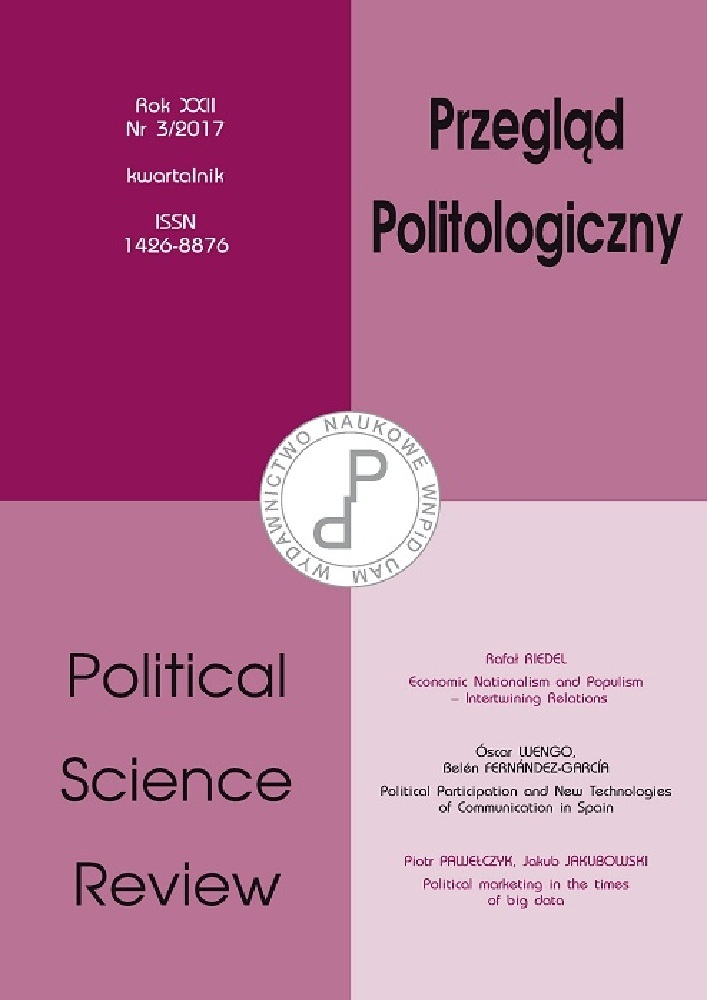Abstract
The consolidation of the Internet as not only a media outlet, but also a multifunctional platform, has put into question the traditional relationship between media and political participation. The latest political developments in Spain, such as the 15-M movement or the success of Podemos, show that new technologies increase the options for new and fresh ways of political activism. This study provides a diagnosis of the role played by new technologies of communication, particularly the Internet, in political activism in Spain. The results show a noteworthy dissemination of the Internet as a political information source, as well as a platform to participate in politics. In addition, the analysis suggests that online participation is a phenomenon more popular among young people, with high studies and located on the ideological left. This profile is similar to that of citizens who support the new political forces like Podemos and the different citizens’ movements which are demanding a reconfiguration of the democratic system in Spain.References
Bennett L. W. (2003), Communicating Global Activism. Information, “Communication & Society”, vol. 6, no. 2, pp. 143–266.
Cappella J., Jamieson C. (1997), Spiral of Cynicism: The Press and the Public Good, Oxford University Press, New York.
Castells M. (2012), Redes de Indignación y Esperanza, Alianza, Madrid.
Dahlgren P. (2004), Foreword, in: W. Van de Donk, B. Loader, P. Nixon, D. Rucht, Cyberprotest: New Media, Citizens and Social Movements, Routledge, London, pp. 6–17.
Dimitrova D., Shehata J., Strömback J., Nord L. W. (2014), The effects of digital media on political knowledge and participation in election campaigns: evidence from panel data, “Communication Research”, vol. 41, no. 1, pp. 95–118.
Easton D. (1965), A systems analysis of political life, Wiley, New York.
Fallows J. (1996), Breaking the News: How the Media Undermine American Democracy, Pantheon, New York.
Hessel S. (2011), ¡Indignaos! Un alegato contra la indiferencia y a favor de la insurrección pacífica, Destino, Madrid.
Holtz-Bacha C. (1990), Videomalaise Revisited: Media Exposure and Political Alienation in West Germany, “European Journal of Communication”, no. 5, pp. 73–85.
Lichter R. S., Amundson D. R. (1994), Less News is Worse News: Television Coverage of Congress, 1972–1992. in: Congress, the Press, and the Public, eds. T. E. Mann, N. J. Ornstein, Brookings Institution Press, Washington, pp. 131–140.
Luengo O. (2005), Media Malaise Revisited: Media Exposure and Political Activism in Europe, “Central European Political Science Review”, vol. 6, no. 19, pp. 72–88.
Luengo O. (2012), Internet y nuevos repertorios de acción colectiva en Europa. ¿Invalida el 15M el malestar mediático?, in: Ciberpolítica. Las nuevas formas de acción y comunicación políticas, ed. R. Cotarelo, Tirant Lo Blanch, Valencia, pp. 257–278.
Luengo O., Maurer M. (2009), A Virtuous Circle for All? Media Exposure and Political Trust in Europe, “CONfines”, no. 5/9, pp. 39–48.
Luengo O., Marín J. (2016), Communication Strategies and New Political Movements, in: Beyond the Internet; Unplugging the Protest Movement Wave, eds. R. Figueiras, P. Espirito Santo, Routledge, London, pp. 53–75.
Newton K. (1999), Mass Media Effects: Mobilisation or Media Malaise, “British Journal of Political Science”, no. 29, pp. 577–599.
Norris P. (1996), Does Television Erode Social Capital? A Reply to Putnam, “Political Science and Politics”, vol. 29, no. 3, pp. 474–480.
Norris P. (1999), Introduction: The Growth of Critical Citizens?, in: Critical Citizens: Global Support for Democratic Government, ed. P. Norris, Oxford University Press, Oxford, pp. 1–27.
Norris P. (2000), A Virtuous Circle: Political Communication in Postindustrial Societies, Cambridge University Press, New York.
Patterson T. (1993), Out of Order, Knopf, New York.
Petray T. L. (2011), Protest 2.0: online interactions and Aboriginal activists, “Media Culture Society”, vol. 33, no. 6, pp. 923–940.
Putnam R. D. (2000), Bowling Alone, Simon & Schuster, New York.
Putnam R. D., Pharr S. J., Dalton R. J. (2000), Introduction: What’s Troubling the Trilateral Democracies, in: Disaffected Democrats: What´s Troubling the Trilateral Democracies, eds.
R. D. Putnam, S. J. Pharr, Princeton University Press, Princeton, pp. 3–27.
Robinson M. (1976), Public affairs television and the growth of political malaise: The case of The Selling the Pentagon, “American Political Science Review”, no. 70, pp. 409–432.
Robinson M., Sheehan M. A. (1983), Over the Wire and on TV. CBS and UPI in Campaign ’80, Russell Sage Foundation, New York.
Van De Donk W., Loader B. D., Nixon P. G., Rucht D. (2004), Cyberprotest: New media, citizens and social movements, Routledge, London–New York.
Yamamoto M., Kushin M. (2014), More harm than Good? Online media use and political disaffection among college students in the 2008 election, “Journal of Computer-Mediated Communication”, no. 19, pp. 430–445.
Zhang W., Johnson T. J., Bichard S. L. (2010), The Revolution Will be Networked The Influence of Social Networking Sites on Political Attitudes and Behaviour, “Social Science Computer Review”, vol. 28, no. 1, pp. 75–92.
